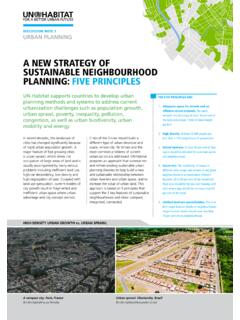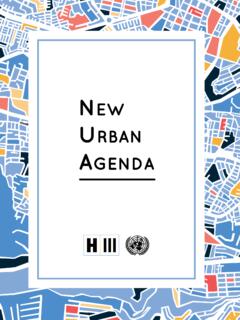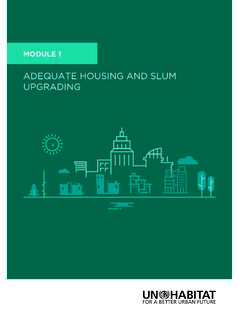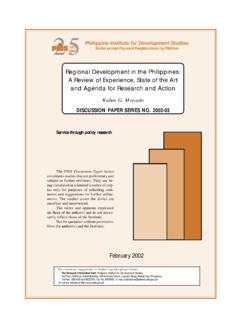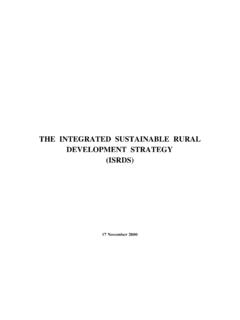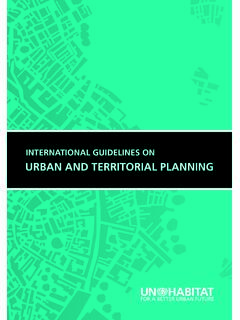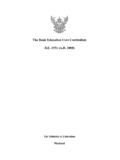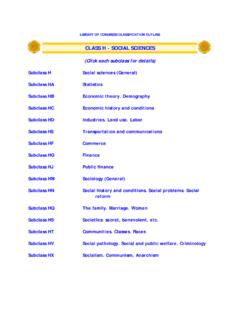Transcription of URBANIZATION AND DEVELOPMENT - UN-Habitat
1 URBANIZATION AND DEVELOPMENTE merging FuturesWORLD CITIES REPORT 2016 World Cities report 2016 URBANIZATION and DEVELOPMENT :emerging FUtUresFirst published 2016 by United Nations Human Settlements Programme ( UN-Habitat )Copyright United Nations Human Settlements Programme, 2016 All rights reservedUnited Nations Human Settlements Programme ( UN-Habitat ) Box 30030, Nairobi, Kenya Tel: +254 20 7621 234 Fax: +254 20 7624 266/7 Website: designations employed and the presentation of the material in this report do not imply the expression of any opinion whatsoever on the part of the Secretariat of the United Nations concerning the legal status of any country, territory, city or area, or of its authorities, or concerning delimitation of its frontiers or boundaries, or regarding its economic system or degree of DEVELOPMENT .
2 The analysis, conclusions and recommendations of this report do not necessarily reflect the views of the United Nations Human Settlements Programme or its Governing Report is produced with official data provided by governments and additional information gathered by the Global Urban Observatory. Cities and countries are invited to update data relevant to them. It is important to acknowledge that data varies according to definition and sources. While UN-Habitat checks data provided to the fullest extent possible, the responsibility for the accuracy of the information lies with the original providers of the data. Information contained in this Report is provided without warranty of any kind, either express or implied, including, without limitation, warranties of merchantability, fitness for a particular purpose and non-infringement.
3 UN-Habitat specifically does not make any warranties or representations as to the accuracy or completeness of any such data. Under no circumstances shall UN-Habitat be liable for any loss, damage, liability or expense incurred or suffered that is claimed to have resulted from the use of this Report, including, without limitation, any fault, error, omission with respect thereto. The use of this Report is at the User s sole risk. Under no circumstances, including, but not limited to negligence, shall UN-Habitat or its affiliates be liable for any direct, indirect, incidental, special or consequential damages, even if UN-Habitat has been advised of the possibility of such Number: HS/038/16 EISBN Number (Series): 978-92-1-133395-4 ISBN Number (Volume): 978-92-1-132708-3 iii WORLD CITIES REPORT 2016 ForewordBan Ki-moon secretary-general United nationstive and negative sides of this ledger, cities have been a primary arena where change takes the world has transformed, so have urban areas.
4 Today, cities are home to 54 per cent of the world s population, and by the middle of this century that figure will rise to 66 per cent. While cities face major problems, from poverty to pollution, they are also powerhouses of economic growth and catalysts for inclusion and innova-tion. With vision, planning and financing, cities can help provide solutions for the world. this year s United nations Conference on Housing and sustainable Urban DEVELOPMENT known as Habitat iii in Quito, ecuador, is a timely and important opportunity. it takes place as the world embarks on efforts to implement the 2030 agenda for sustainable develop-ment, which gives a prominent role to cities. Habitat iii is expected to discuss and agree on a new Urban agenda aimed at enhancing the contribution of cities to sustain-able DEVELOPMENT , and at ensuring that cities are inclu-sive, safe, resilient and sustainable.
5 This new World Cities report presents a number of issues that this new Urban agenda should address. i commend its analysis and documentation to a wide global audience, and encourage all stakeholders to make Habitat iii a success in pointing the way forward in designing and managing cities so that all their inhabitants can enjoy lives of the 1996 Habitat ii Conference in istanbul, the world has faced many serious challenges, including rising inequality, increasing insecurity in many places and the widening impacts of climate change everywhere. but we have also made major advances in medicine, life expectancy, information and com-munications technology, governance and human knowledge. on both the posi-iv WORLD CITIES REPORT 2016 Introductionover these years.
6 Many of these changes have been for the better, but others for the worst. the growth of the world s cities, from the north to the south, and from the east to the west, is ingrained in a culture of short-term economic benefit and often unbridled consumption and production practices that compromise the sustainability of the environment. the causes may vary according to different contexts, but uncontrolled growth , privatization of public goods, lack of regulations and institu-tions as well as forms of collective indolence are often the key factors behind a model of URBANIZATION that is becoming highly unsustainable. URBANIZATION is at the same time a positive force underpinning profound social, political and economic transformation. URBANIZATION and growth go hand in hand, and no one can deny that URBANIZATION is essential for socio- economic transformation, wealth generation, prosperity and DEVELOPMENT .
7 As this report asserts, the emerging future of cities largely depends on the way we plan and manage URBANIZATION , and the way we leverage this trans-formative process to provide the setting, the underlying base and also the momentum for global change 1. the analysis of urban DEVELOPMENT of the past twenty years presented in this first edition of the World Cities Report shows, with compelling evidence, that there are new forms of collaboration and cooperation, planning, governance, finance and learning that can sustain posi-tive change. the report unequivocally demonstrates that the current URBANIZATION model is unsustainable in many respects, puts many people at risk, creates unnecessary costs, negatively affects the environment, and is intrinsi-cally unfair.
8 It conveys a clear message that the pattern of URBANIZATION needs to change in order to better respond to the challenges of our time, to address issues such as inequality, climate change, informality, insecurity, and the unsustainable forms of urban expansion. the Habitat agenda adopted at the United nations Conference on Human settlements (Habitat ii) in 1996 was influential in the recognition of the right to adequate housing, sustainable human settlements devel-opment in an urbanizing world, and the increased partici-pation of the private sector and non-governmental organi-zations in the URBANIZATION process. it reinforced the role of local authorities and stirred progress in strengthening fiscal and financial management capacities. However, in general terms, implementation, financing and monitoring have remained major challenges.
9 The new Urban agenda that is expected to be adopted at the Habitat iii Conference cannot afford to ignore these shortcomings. it should convey a sense of urgency in the implementation of policies and actions that can no longer depend on political schedules or opportun-istic moments, but should, instead, be set in clear, well-defined agendas. the new Urban agenda should adopt a city-wide approach to DEVELOPMENT with concrete actions, setting out clear funding mechanisms and effective means of implementation and monitoring. Joan Clos Under-secretary-general, United nations executive director, Un-Habitatthe world has changed remarkably since the Habitat ii Conference took place in istanbul in 1996. twenty years appears to be a short span of time, but our ideas, practices, modes of production and consumption, demographic struc-tures, as well as education and health conditions have drastically changed.
10 The way cities are shaped, their form and functionality have also been transformed 1. United Nations (2013) Sustainable URBANIZATION , thematic think piece prepared for the 2030 DEVELOPMENT agenda, New WORLD CITIES REPORT 2016 Habitat iii and the new Urban agenda should establish critical connections to the 2030 agenda for sustainable DEVELOPMENT and other international agree-ments. the report is very explicit on the need to ensure a strong convergence among these agendas as a way of complementing and improving the implementation of the sustainable DEVELOPMENT goals (sdgs), particularly those with an urban component. the research, data, knowledge, practice and experience of UN-Habitat has facilitated the production of this highly informative report. its different chapters collectively present a path to sustainable urban develop-ment that the new Urban agenda must consider.
